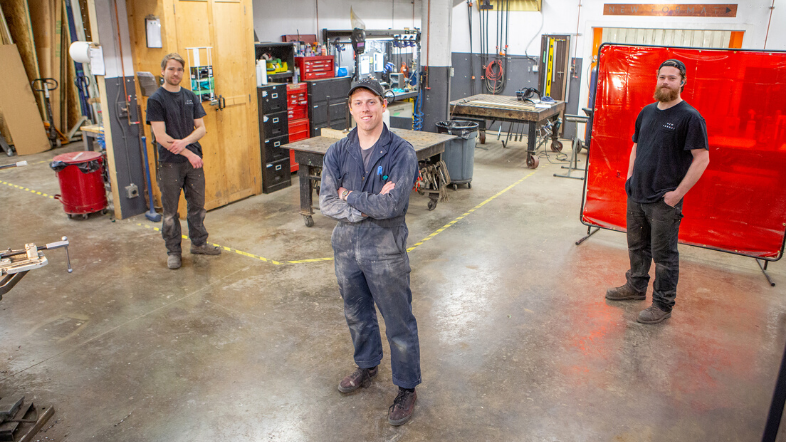Metal Fabricator Skills
Showcased at Design Studio
Metal Fabricator Skills
Showcased at Design Studio

Tradespeople at a furniture and architectural design company show how diverse the trades can be.
Unique furniture and home/office décor might not be the first thing that comes to mind when you think of the skilled trades.
Using his skills as a certified welder, Henry Norris established New Format Studio, a furniture and architectural design firm in Vancouver that manufacturers a range of seating, case goods, and art objects for the home, office, and public spaces. His five-person team works out of a studio workshop in East Vancouver.
The small crew has been fortunate to continue working during the COVID-19 pandemic. A large shop lets them maintain appropriate physical distancing from each other, and they have comprehensive cleaning and sanitizing procedures. They’ve also limited outside contact, so there aren’t any studio visits or in-house meetings.
Henry completed his apprenticeship in welding with SkilledTradesBC in 2013, and he’s also a self-taught designer.
“I got my ticket and my first job welding dumpsters before moving through the industry and working in a variety of commercial environments,” says Henry. “When I founded my own studio four years ago, my focus had changed to furniture and fine architectural work. We’ve designed dozens of products, developed hundreds of proprietary finishes and textures, and expanded from metal exclusively to working with glass, resin, stone, and wood.”
Henry’s also an employer sponsor with SkilledTradesBC and has been helping apprentices with their trades journey for many years.
“I became a sponsor because having accreditation is a valuable thing that people can take forwards in life,” says Henry. “It’s not necessary for the path everyone wants to take, but having a Red Seal in any trade is an important thing if people ever end up moving or changing professions or want to move from the artisan side of manufacturing back to industrial. I value diversity of experience too, so having people learn outside the studio is important. Our people have learned things at fabrication school that we’ve integrated into our own style of manufacturing.”
That’s led to interesting and award-winning projects, including a large art commission for Ts’msyen artist Phil Gray, which lives in the Telus Garden building in downtown Vancouver. New Format was charged with finding an innovative way to take a style of work traditionally executed in cedar and translate it into copper.
The fabrication team includes Harry Neilson and Colin Tapp. Harry earned his Red Seal in metal fabrication in March. Colin Tapp is a first-year metal fabrication apprentice, but he already has five years of industry experience under his toolbelt.
Harry’s love for vintage cars—which gave him an understanding of antiquated production processes used for these cars, like soldering, sheet metal, and material preparation and finishing—eventually led him to metal fabrication.
“I’d always been interested in learning how to manipulate and control this medium,” says Harry. “Metal is an incredibly interesting material that can allow you to realize creations that are not possible with other materials.”
Harry’s been with New Format for his entire apprenticeship; the Ts’msyen art was one of the projects he worked on.
“Henry has taught me a lot during my apprenticeship,” says Harry. “He’s helped me with staying focused on the task at hand and how to manage and prioritize time. His help has also come in the way of leading by example. He’s a skilled tradesperson and has an attitude and method that is conducive to success. I’m proud to be one of two fabricators working for New Format Studio, which is developing an international reputation as a bespoke furniture maker.”
Colin’s start in the craft came from a high school art metal class that initially piqued his interest in welding and the possibilities of working with metals.
“I got into steel fabrication because I always found welding intriguing and wanted a trade that involved welding but allowed me to do more than just push welding rod all day,” says Colin.
Henry recognized Colin’s desire to achieve more and has been teaching him techniques to elevate his work.
“Colin has a long family history of tinkering and is a skilled generalist, so if we need a machine fixed or a tool invented, he’s the guy,” says Henry. “We hired him as a shop fabricator and began integrating him into other functions on the shop floor, as his broad skillset became more apparent.”
Colin recently created a set of six patinated steel Mers side tables for Nike’s new sports research lab, the LeBron James Building, in Oregon.
“Henry has provided me with an outstanding work environment, where I can look forward to coming in to every day, all while challenging my abilities as a fabricator,” says Colin. “I walk away at the end of each day being thankful I’ve landed where I have.”
Harry sees his future developing his skill in metalworking by taking up the long-lost skill of panel beating, which is the forming of steel and aluminum into a compound shape. Henry says very few people practice this—it’s done on vintage cars and in artistic metalwork.
Until recently, Colin had always wanted to own his own metal fabrication shop, but since working at New Format Studio, he aspires to see where he can go and what he can do for the company.
“If you’re starting out in the steel/metal fabrication trade, it’s good to work with different companies, as you need to see what you like and what you don’t,” says Colin. “There are many different avenues in the metal trades, so try to find the one that will make you enjoy every day you work.”
